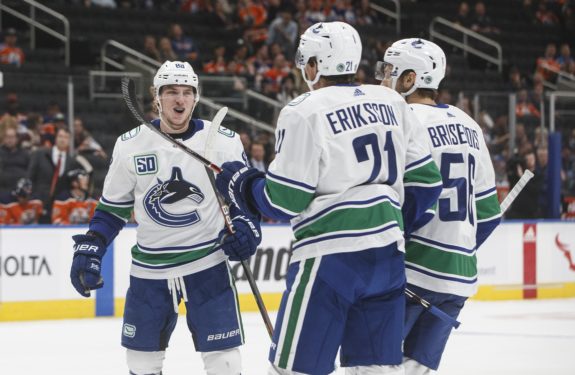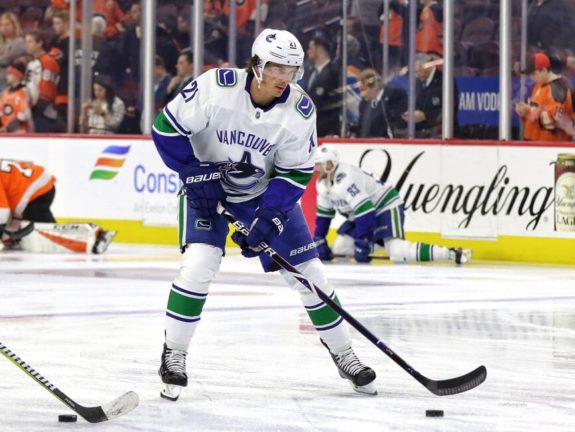NHL general managers have long been fixated on signing big contracts on the first day of free agency in an attempt to kick-start their teams’ potential. From the shiny seven-year, $42 million deal Kyle Okposo signed during the 2016-17 offseason with the Buffalo Sabres to Andrew Ladd’s $38.5 million deal with the New York Islanders, these desired unrestricted free agents have been showered by signing bonuses and even heavier cap hits.
Over the past three years, however, the league has begun to feel the downfalls of signing long-term deals with mid-aged players who simply cannot produce at the level they once could. The Vancouver Canucks were one of many teams eager to sign a goalscorer during the 2016-17 offseason. With high hopes of adding an offensive edge to the lineup, general manager Jim Benning pursued UFA Loui Eriksson and closed on a six-year, $36 million contract after the winger’s 30-goal season with the Boston Bruins.
More than midway through his contract, it’s impossible to ignore the shortcomings of the veteran player. Despite serving as one of the league’s most valuable penalty killers at one point in his career, Eriksson is scoreless this season, posting a meager two points in his last 20 NHL games with the Canucks. While it may not be a pressing issue at the moment, the club should begin looking at ways to alleviate the weight of Eriksson’s cap hit by making one of the following moves.

Buy Out His Contract
This is standard practice when dealing with an underperforming, overpaid player, but in Loui Eriksson’s case, this option makes the least sense.
What makes Eriksson’s contract different is that it is made up almost entirely of signing bonuses – $28 million of it to be exact. The drawback with this, compared to ordinary base salary buyouts, is that signing bonuses must be paid in full and cannot be distributed over multiple years.
If the Canucks buy out Eriksson’s contract at the end of this season, they will still have a $5.6 million cap hit for the next two seasons. That sum will be reduced by $2 million in the 2021-22 season, leaving just over $666,667 for each of the next two. On the flip side, it would allow some cap flexibility in the 2021-22 season, when some of the club’s top players like Elias Pettersson and Brock Boeser will be negotiating new contracts. In all, it’s not much of an impact move by the Canucks and isn’t a viable option in addressing the team’s broader cap concerns.
Keep Trying to Trade Him
Now, don’t take this the wrong way, Eriksson is a sound hockey player. If he was a free agent, an NHL team would be eager to sign him for less than $3 million. However, at a $6 million cap hit, Benning has not been able to find a team willing to take Eriksson on, which is understandable given the 34-year-old winger has underperformed for the Canucks this season.
On Nov. 14, Eriksson played a season low of just under six minutes during the Canucks’ matchup with the Stars, which included three shifts in the third period and none in the final 12 minutes. He also had zero hits and four blocked shots, indicating a severe lack in offensive accumen. His underwhelming scoresheet and heavy cap hit will deter the interest of other teams in the NHL, but some argue that’s not where the club should be looking.

Send Him To Utica
If the Canucks were to make a move, it would make sense to send Eriksson to the American Hockey League to play in Utica. In this case, he would get some additional playing time and the Canucks would receive cap relief of over $1 million.
Sending Eriksson to the minors, however, won’t be as easy as some think because there are rules in place. Since 2012, The NHLPA has tightened rules around the league, restricting teams from burying a high percentage of contract dollars in the minor league. This deal ultimately protects elite UFA’s from signing big deals and not getting what they signed up for. While this option provides the Canucks the choice to bury Eriksson’s contract for partial relief, the winger would still be getting paid $6 million by the team to not play.
Play Him in Hopes He’ll Find His Way
In the end, it may not be worth sending Eriksson down, trading him, or buying him out. Despite his inability to click with Canucks’ dominant first- and second-line players, Eriksson has been a reliable checker and dangerous penalty killer throughout his career. With 11 goals and 29 points in 81 games last season, he is still a player many would like to have on their team.
It’s important to remember that the Canucks have rebuilt this new team around a handful of key young talent, supported by summer acquisitions of four mid-career veterans to improve their offensive play. So in his defense, it’s been tough to mix-up the lineup of a team that’s doing well, but now that the Canucks have lost eight of their last 11 games, this might be an opportunity for Eriksson to prove his worth and find chemistry in a top-six role, as intended.
With a number of early injuries impacting the Canucks line-up this year, Eriksson has suited up in replacement of key penalty killers like Tyler Motte, but this will not continue as these injured forwards return to the lineup. It’s important to note that Eriksson is also up against notable Utica players like Adam Gaudette who, by the looks of it, aren’t going anywhere anytime soon.
The reality is, Eriksson is 23 games into the season and not much has changed. Looking ahead into the 2021-22 season, the Canucks will be desperately in a bind to make some big offers and Eriksson’s expense will factor into those negotiations. While there may be an opportunity for him to morph into the player he once was, it is important to consider all options as the club approaches some crucial years ahead.